予習シリーズ6年算数Pythonプログラム教材


和と差の文章題 第1回
例1
x+5=y
x+y=17匹
import numpy as np
import matplotlib.pyplot as plt
# 行列とベクトルを定義
A = np.array([[1, -1], [1, 1]])
b = np.array([-5, 17])
# 逆行列を使って解を求める
x, y = np.linalg.solve(A, b)
print(f"Solution: x = {x}, y = {y}")
# グラフの描画
x_values = np.linspace(-10, 10, 400)
y1_values = x_values + 5
y2_values = 17 - x_values
plt.plot(x_values, y1_values, label="y = x + 5")
plt.plot(x_values, y2_values, label="y = 17 - x")
# 解をプロット
plt.scatter(x, y, color='red', zorder=5)
plt.text(x, y, f" ({x}, {y})", fontsize=12, verticalalignment='bottom')
plt.axhline(0, color='black',linewidth=0.5)
plt.axvline(0, color='black',linewidth=0.5)
plt.grid(color = 'gray', linestyle = '--', linewidth = 0.5)
plt.legend()
plt.xlabel('x')
plt.ylabel('y')
plt.title('Graph of the equations 1x + 5 = y and x + y = 17')
plt.show()
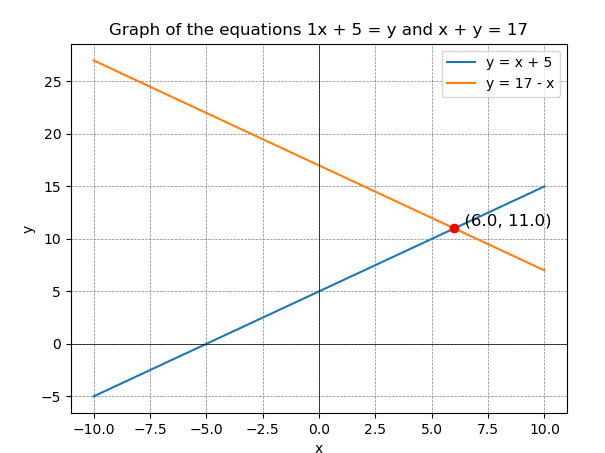
例2
y+6=x
x+4=z
x+y+z=40人
import numpy as np
import matplotlib.pyplot as plt
from mpl_toolkits.mplot3d import Axes3D
# Define the matrix and vector
A = np.array([[-1, 1, 0],
[1, 0, -1],
[1, 1, 1]])
b = np.array([-6, -4, 40])
# Solve for x, y, z
solution = np.linalg.solve(A, b)
x, y, z = solution
print(f"Solution: x = {x}, y = {y}, z = {z}")
# Plotting the solution
fig = plt.figure()
ax = fig.add_subplot(111, projection='3d')
# Define the range for x and y
x_values = np.linspace(-10, 50, 100)
y_values = np.linspace(-10, 50, 100)
X, Y = np.meshgrid(x_values, y_values)
# Define the planes for the equations
Z1 = X - 4 # z = x + 4
Z2 = 40 - X - Y # x + y + z = 40
# Plot the planes
ax.plot_surface(X, Y, Z1, alpha=0.5, rstride=100, cstride=100, color='red', label='x + 4 = z')
ax.plot_surface(X, Y, Z2, alpha=0.5, rstride=100, cstride=100, color='blue', label='x + y + z = 40')
# Plot the solution point
ax.scatter(x, y, z, color='black', s=100)
ax.text(x, y, z, f"({x:.2f}, {y:.2f}, {z:.2f})", color='black')
# Set labels
ax.set_xlabel('X axis')
ax.set_ylabel('Y axis')
ax.set_zlabel('Z axis')
plt.title('3D Graph of the Equations')
plt.show()
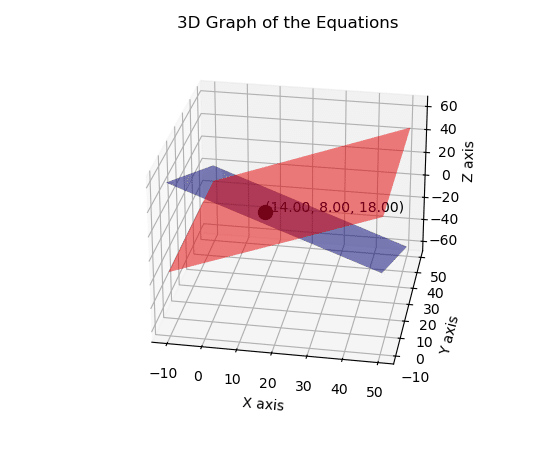
例3
x+y=20個
70x+120y=1850人
import numpy as np
import matplotlib.pyplot as plt
# Define the matrix and vector
A = np.array([[1, 1],
[70, 120]])
b = np.array([20, 1850])
# Solve for x and y using the inverse of A
solution = np.linalg.solve(A, b)
x, y = solution
print(f"Solution: x = {x}, y = {y}")
# Define the range for plotting
x_values = np.linspace(0, 20, 400)
y1_values = 20 - x_values
y2_values = (1850 - 70 * x_values) / 120
# Plot the equations
plt.plot(x_values, y1_values, label='x + y = 20')
plt.plot(x_values, y2_values, label='70x + 120y = 1850')
# Plot the solution point
plt.scatter(x, y, color='red', zorder=5)
plt.text(x, y, f" ({x:.2f}, {y:.2f})", fontsize=12, verticalalignment='bottom')
# Set up the plot
plt.axhline(0, color='black', linewidth=0.5)
plt.axvline(0, color='black', linewidth=0.5)
plt.grid(color='gray', linestyle='--', linewidth=0.5)
plt.legend()
plt.xlabel('x')
plt.ylabel('y')
plt.title('Graph of the equations x + y = 20 and 70x + 120y = 1850')
plt.show()

例4
30x-100y=3720円
x+y=150枚
import numpy as np
import matplotlib.pyplot as plt
# Define the equations
# 1. 30x - 100y = 3720
# 2. x + y = 150
# Rewriting the equations in the form y = mx + b
# For 30x - 100y = 3720 => y = (30/100)x - 3720/100
def line1(x):
return (30/100)*x - 3720/100
# For x + y = 150 => y = -x + 150
def line2(x):
return -x + 150
# Define the x values for which you want to plot the lines
x = np.linspace(0, 150, 400)
# Calculate the y values for each line
y1 = line1(x)
y2 = line2(x)
# Plot the lines
plt.figure(figsize=(10, 6))
plt.plot(x, y1, label='30x - 100y = 3720')
plt.plot(x, y2, label='x + y = 150')
# Calculate the intersection point
A = np.array([[30, -100], [1, 1]])
B = np.array([3720, 150])
intersection = np.linalg.solve(A, B)
plt.scatter(*intersection, color='red') # Plot the intersection point
# Add labels and legend
plt.xlabel('x')
plt.ylabel('y')
plt.title('Plot of the system of equations')
plt.legend()
plt.grid(True)
# Show the plot
plt.show()
# Slopes of the lines
slope1 = 30 / 100
slope2 = -1
print(f"Slope of the line 30x - 100y = 3720: {slope1}")
print(f"Slope of the line x + y = 150: {slope2}")
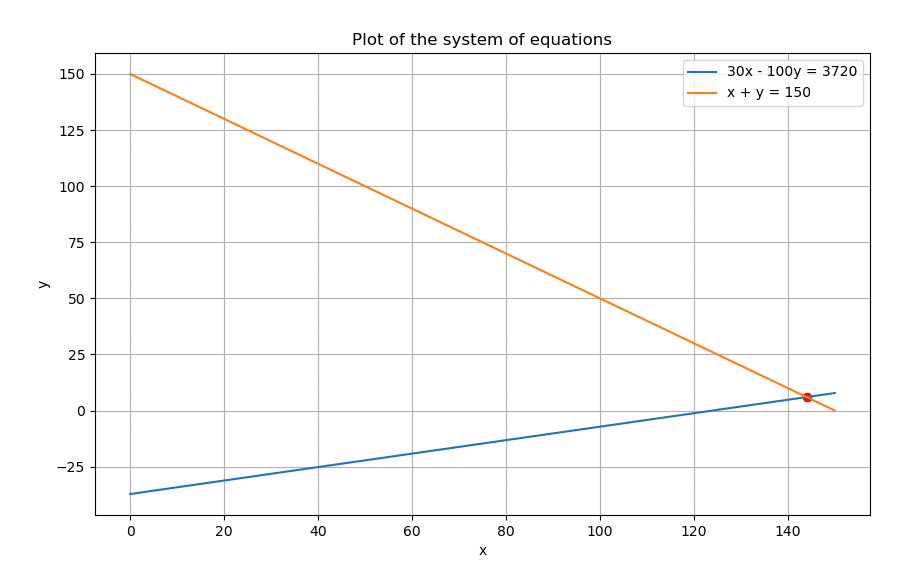
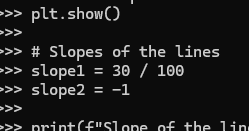
例8
x=2y
2x+5y=720円
import numpy as np
import matplotlib.pyplot as plt
# Define the range for y
y = np.linspace(0, 200, 400)
# Define the equations
x1 = 2 * y
x2 = (720 - 5 * y) / 2
# Plot the equations
plt.figure(figsize=(10, 6))
plt.plot(x1, y, label='x = 2y')
plt.plot(x2, y, label='2x + 5y = 720')
# Calculate the intersection point
y_intersect = 80 # from solving the system manually or with another method
x_intersect = 2 * y_intersect
# Plot the intersection point
plt.plot(x_intersect, y_intersect, 'ro') # red dot
plt.text(x_intersect + 5, y_intersect, f'Intersection\n(x={x_intersect}, y={y_intersect})', color='red')
# Labels and title
plt.xlabel('x')
plt.ylabel('y')
plt.title('Plot of the system of equations')
plt.legend()
plt.grid(True)
plt.axhline(0, color='black',linewidth=0.5)
plt.axvline(0, color='black',linewidth=0.5)
plt.show()
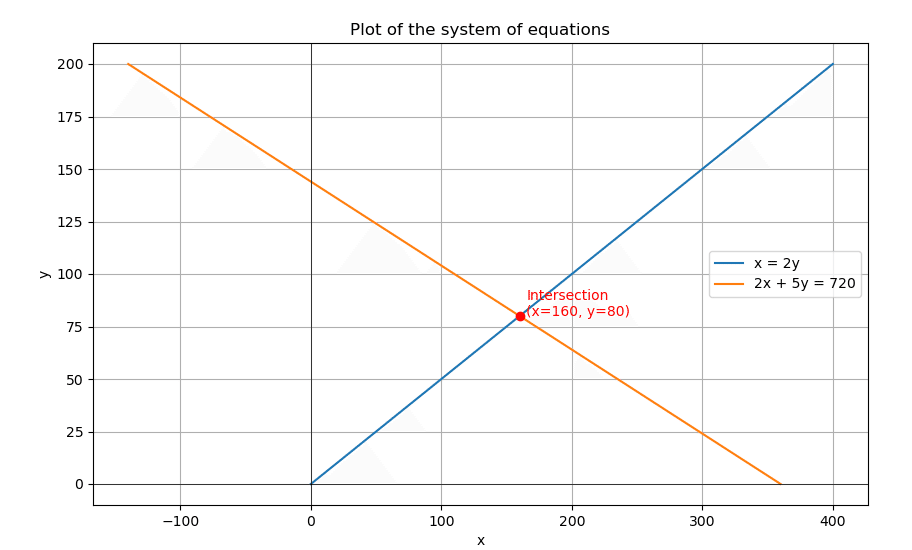
例19
x=80A+160円
x=50A+250円
import numpy as np
import matplotlib.pyplot as plt
from sympy import symbols, solve
# Define variables
A, x = symbols('A x')
# Define equations
eq1 = x - 80*A - 160
eq2 = x - 50*A - 250
# Solve the system of equations
solution = solve((eq1, eq2), (A, x))
A_value = solution[A]
x_value = solution[x]
# Define range of A values
A_values = np.linspace(0, 10, 100)
# Define equations
def equation1(A):
return 80*A + 160
def equation2(A):
return 50*A + 250
# Calculate corresponding x values
x_values1 = equation1(A_values)
x_values2 = equation2(A_values)
# Plot the equations
plt.plot(A_values, x_values1, label='x = 80A + 160')
plt.plot(A_values, x_values2, label='x = 50A + 250')
# Plot the solution point
plt.plot(A_value, x_value, 'ro', label='Solution')
# Add labels and legend
plt.xlabel('A')
plt.ylabel('x')
plt.title('Equations Plot with Solution')
plt.legend()
# Show the plot
plt.grid(True)
plt.show()
# Print the solution
print("Solution:")
print("A value:", A_value)
print("x value:", x_value)
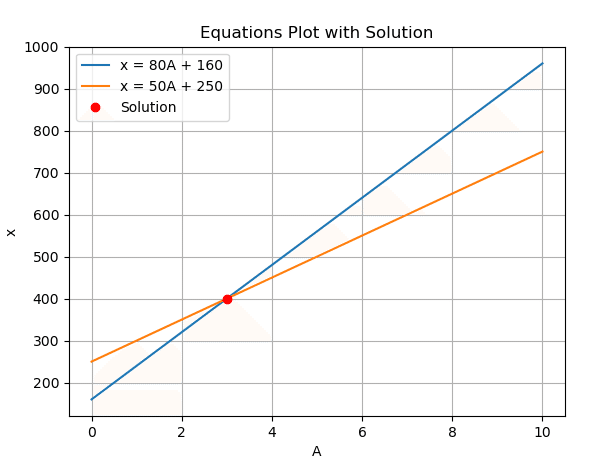
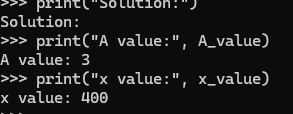
第2回目 数の規則性
例9 等差数列
等差数列(n)=はじめの数+公差×(n-1)
等差数列の和(n)=((はじめの数+最後の数)×n)×(1/2)
import matplotlib.pyplot as plt
def arithmetic_sequence(a, d, n):
"""
Function to generate terms of an arithmetic sequence.
Parameters:
a (float): First term of the sequence.
d (float): Common difference of the sequence.
n (int): Number of terms in the sequence.
Returns:
sequence (list): List of terms in the arithmetic sequence.
"""
sequence = [a + d * (i - 1) for i in range(1, n + 1)]
return sequence
def arithmetic_sequence_sum(a, l, n):
"""
Function to calculate the sum of an arithmetic sequence.
Parameters:
a (float): First term of the sequence.
l (float): Last term of the sequence.
n (int): Number of terms in the sequence.
Returns:
sum (float): Sum of the arithmetic sequence.
"""
return ((a + l) * n) / 2
# Specify the starting number, common difference, and number of terms
start_num = 1
common_diff = 3
num_terms = 10
# Generate the arithmetic sequence
sequence = arithmetic_sequence(start_num, common_diff, num_terms)
# Term numbers
term_numbers = list(range(1, num_terms + 1))
# Cumulative sums
sums = [arithmetic_sequence_sum(start_num, term, i) for i, term in enumerate(sequence, start=1)]
# Plotting the graphs
plt.figure(figsize=(10, 5))
# Arithmetic sequence graph
plt.subplot(1, 2, 1)
plt.plot(term_numbers, sequence, marker='o')
plt.title('Arithmetic Sequence')
plt.xlabel('Term Number')
plt.ylabel('Term Value')
# Sum graph
plt.subplot(1, 2, 2)
plt.plot(term_numbers, sums, marker='o')
plt.title('Sum of Arithmetic Sequence')
plt.xlabel('Number of Terms')
plt.ylabel('Sum')
plt.tight_layout()
plt.show()

例12
外側まわり個数=(N-1)×4個
import matplotlib.pyplot as plt
def calculate_outer_edges(N):
# Calculate the number of outer edges using the formula (N-1) * 4
outer_edges = (N - 1) * 4
return outer_edges
# Example usage:
N_values = list(range(1, 11)) # Example range of N values
outer_edges_values = [calculate_outer_edges(N) for N in N_values]
# Plotting the graph
plt.plot(N_values, outer_edges_values, marker='o', linestyle='-')
plt.xlabel('N')
plt.ylabel('Number of outer edges')
plt.title('Number of outer edges vs. N')
plt.grid(True)
plt.show()
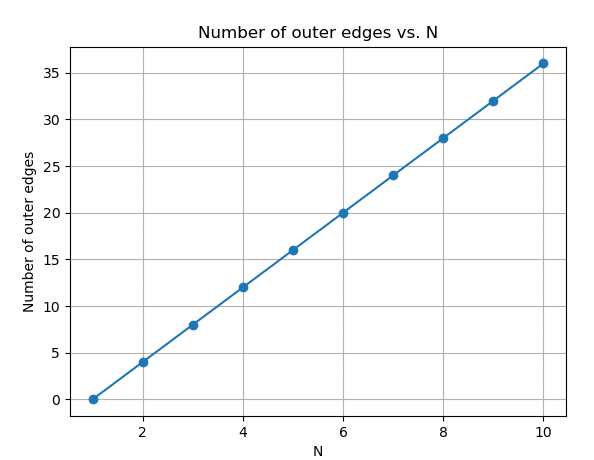
例13
三角数=1+2+3+4…=(1/2)n(n+1)
import matplotlib.pyplot as plt
def triangular_number(n):
return (n * (n + 1)) // 2
# Compute triangular numbers within a specified range
start = 1
end = 10
triangular_numbers = [triangular_number(n) for n in range(start, end+1)]
# Plot the computed triangular numbers
plt.plot(range(start, end+1), triangular_numbers, marker='o')
plt.title('Triangular Numbers')
plt.xlabel('n')
plt.ylabel('Triangular Number')
plt.grid(True)
plt.show()
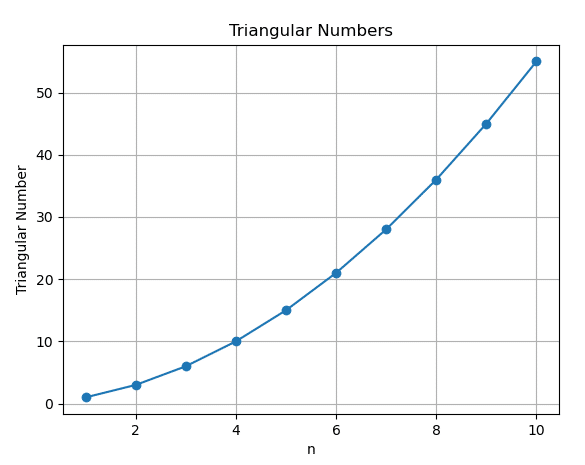
上3回 平面図形(1)
例15
x^2+y^2=A^2
(A,0)と(0,A)を線で結ぶ、
(A,0)と(0,-A)を線で結ぶ、
(-A,0)と(0,-A)を線で結ぶ、
(-A,0)と(0,A)を線で結ぶ、
0.57公式=A×A×π×(1/4)-A×A×(1/2)
import matplotlib.pyplot as plt
import numpy as np
# Circle radius
A = 5
# Circle center
center = (0, 0)
# Equation of the circle
theta = np.linspace(0, 2*np.pi, 100)
x = A * np.cos(theta)
y = A * np.sin(theta)
# Coordinates of the lines
lines = [
[(A, 0), (0, A)],
[(0, A), (-A, 0)],
[(-A, 0), (0, -A)],
[(0, -A), (A, 0)]
]
# Plot
plt.figure(figsize=(8, 8))
plt.plot(x, y, label='Circle')
for line in lines:
plt.plot([line[0][0], line[1][0]], [line[0][1], line[1][1]], 'r')
# Calculation of the approximation for 0.57
approximation = A * A * np.pi * (1/4) - A * A * (1/2)
plt.text(0, -6, f'Approximation of 0.57: {approximation:.2f}', fontsize=12, ha='center')
# Graph settings
plt.axis('equal')
plt.xlabel('x')
plt.ylabel('y')
plt.title('Circle and Lines')
plt.grid(True)
plt.legend()
plt.show()

第4回 容器と水量・変化とグラフ
かさの体積と単位換算
例3
横軸分 縦軸cm
(0,0)から(20,10)をひく
(20,10)から(30,60)をひく
import matplotlib.pyplot as plt
# Points on the graph
x_values = [0, 20, 30]
y_values = [0, 10, 60]
# Calculate the slope between the points (0,0) and (20,10)
slope1 = (y_values[1] - y_values[0]) / (x_values[1] - x_values[0])
# Calculate the slope between the points (20,10) and (30,60)
slope2 = (y_values[2] - y_values[1]) / (x_values[2] - x_values[1])
# Print the slopes
print("Slope between (0,0) and (20,10):", slope1)
print("Slope between (20,10) and (30,60):", slope2)
# Plotting the points
plt.plot(x_values, y_values, marker='o')
# Adding labels
plt.xlabel('X-axis (分)')
plt.ylabel('Y-axis (cm)')
# Adding title
plt.title('Graph')
# Show plot
plt.grid(True)
plt.show()

例4
横軸分 縦軸cm
(0,0)から(6,40)をひく
(6,40)から(18,64)をひく
import matplotlib.pyplot as plt
# Coordinates of points
x1, y1 = 0, 0
x2, y2 = 6, 40
x3, y3 = 18, 64
# Plot the points
plt.plot([x1, x2, x3], [y1, y2, y3], 'bo', label='Points')
# Plot the lines
plt.plot([x1, x2], [y1, y2], 'r-', label='Line 1')
plt.plot([x2, x3], [y2, y3], 'g-', label='Line 2')
# Calculate the slopes of the lines
slope1 = (y2 - y1) / (x2 - x1)
slope2 = (y3 - y2) / (x3 - x2)
# Output the slopes of the lines
print("Slope of Line 1:", slope1)
print("Slope of Line 2:", slope2)
# Decorate the plot
plt.xlabel('X')
plt.ylabel('Y')
plt.title('Plot of Points and Lines')
plt.legend()
plt.grid(True)
# Show the plot
plt.show()
# Output the slopes of the lines
print("Slope of Line 1:", slope1)
print("Slope of Line 2:", slope2)
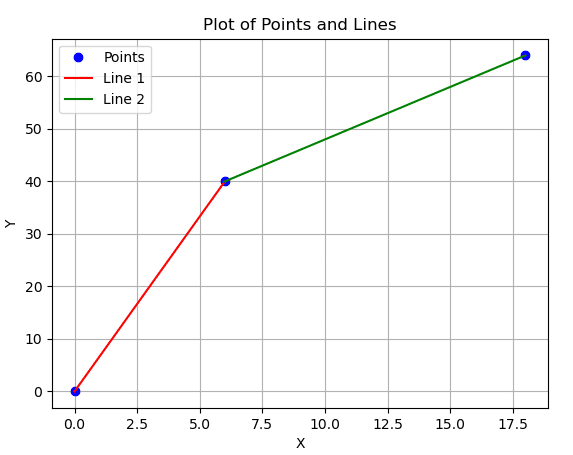
例8
横軸分 縦軸cm
(0,0)から(10,20)をひく 傾きを求める
(21,33)から(35,40)をひく 傾きを求める
交点を求める
import matplotlib.pyplot as plt
def calculate_slope(point1, point2):
# Calculate the slope of the line passing through the given points
x1, y1 = point1
x2, y2 = point2
slope = (y2 - y1) / (x2 - x1)
return slope
def calculate_intersection(slope1, intercept1, slope2, intercept2):
# Calculate the intersection point of two lines
x = (intercept2 - intercept1) / (slope1 - slope2)
y = slope1 * x + intercept1
return x, y
# Points for the first line
x_values1 = [0, 10]
y_values1 = [0, 20]
# Points for the second line
x_values2 = [21, 35]
y_values2 = [33, 40]
# Calculate slopes
slope1 = calculate_slope((0,0), (10,20))
slope2 = calculate_slope((21,33), (35,40))
# Calculate intercepts
intercept1 = 0
intercept2 = 33 - slope2 * 21
# Calculate intersection
intersection = calculate_intersection(slope1, intercept1, slope2, intercept2)
# Plotting
plt.plot(x_values1, y_values1, label='Line 1')
plt.plot(x_values2, y_values2, label='Line 2')
plt.scatter(*intersection, color='red', label='Intersection')
plt.xlabel('X axis')
plt.ylabel('Y axis')
plt.title('Graph of Two Lines and Their Intersection')
plt.legend()
plt.grid(True)
plt.show()

例10
横軸分 縦軸cm
(0,0)から(6,12)をひく
(15,12)から(25,20)をひく
import matplotlib.pyplot as plt
# First line: Points (0, 0) and (6, 12)
x1 = 0
y1 = 0
x2 = 6
y2 = 12
# Calculate slope for the first line
slope1 = (y2 - y1) / (x2 - x1)
# Second line: Points (15, 12) and (25, 20)
x3 = 15
y3 = 12
x4 = 25
y4 = 20
# Calculate slope for the second line
slope2 = (y4 - y3) / (x4 - x3)
# Plotting the lines
plt.plot([x1, x2], [y1, y2], label='Line 1') # Plotting the first line
plt.plot([x3, x4], [y3, y4], label='Line 2') # Plotting the second line
plt.xlabel('X axis') # Labeling x-axis
plt.ylabel('Y axis') # Labeling y-axis
plt.title('Lines and Their Slopes') # Adding a title to the plot
plt.legend() # Adding legend to the plot
plt.grid(True) # Adding grid to the plot
plt.show() # Display the plot
# Output the slopes
print("Slope of the first line:", slope1)
print("Slope of the second line:", slope2)
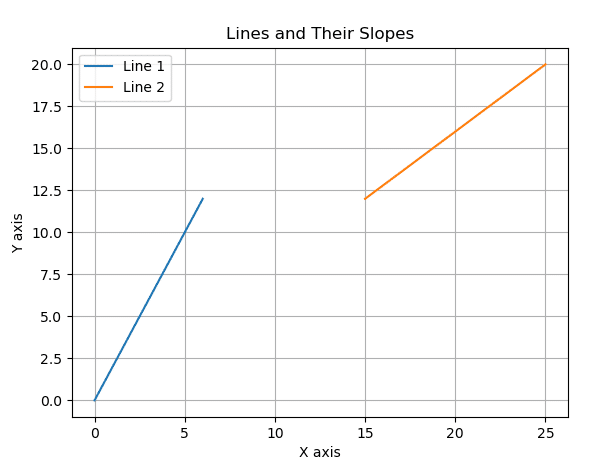
第6回 速さ(1)
(60×60)/1000=3.6km/時
例3
平均の速さ=道のりの合計÷かかった時間合計
例8
横軸分 縦軸m
(0,2280)から(36,0)
(0,0)から(45,2280)
import matplotlib.pyplot as plt
# Coordinates for the first dataset
x1 = [0, 36]
y1 = [2280, 0]
# Coordinates for the second dataset
x2 = [0, 45]
y2 = [0, 2280]
# Plot the graphs
plt.plot(x1, y1, label='Data 1')
plt.plot(x2, y2, label='Data 2')
# Calculate slopes
slope1 = (y1[1] - y1[0]) / (x1[1] - x1[0])
slope2 = (y2[1] - y2[0]) / (x2[1] - x2[0])
# Display slopes
print("Slope of Data 1:", slope1)
print("Slope of Data 2:", slope2)
# Set titles, labels, and legend for the plot
plt.title('Slope Calculation')
plt.xlabel('X-axis')
plt.ylabel('Y-axis')
plt.legend()
# Display grid
plt.grid(True)
# Show the plot
plt.show()
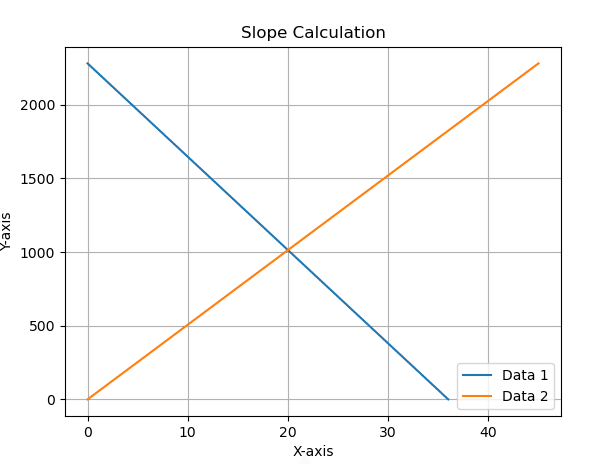

横軸分 縦軸m
(0,405)から(25,1080) 線を引く
(0,0)から(15,1080) 線を引く
交点を求める
import matplotlib.pyplot as plt
# Data points
x1 = [0, 25]
y1 = [405, 1080]
x2 = [0, 15]
y2 = [0, 1080]
# Plot
plt.plot(x1, y1, label='Line 1')
plt.plot(x2, y2, label='Line 2')
# Calculate intersection
# First, find equations of the two lines
# y = mx + c
m1 = (y1[1] - y1[0]) / (x1[1] - x1[0]) # Slope of Line 1
c1 = y1[0] - m1 * x1[0] # y-intercept of Line 1
m2 = (y2[1] - y2[0]) / (x2[1] - x2[0]) # Slope of Line 2
c2 = y2[0] - m2 * x2[0] # y-intercept of Line 2
# Intersection x-coordinate
intersection_x = (c2 - c1) / (m1 - m2)
# Intersection y-coordinate
intersection_y = m1 * intersection_x + c1
# Plot intersection
plt.scatter(intersection_x, intersection_y, color='red', label='Intersection')
# Graph decoration
plt.xlabel('X-axis')
plt.ylabel('Y-axis')
plt.title('Graph with Slopes and Intersection')
plt.legend()
plt.grid(True)
# Display graph
plt.show()
# Output intersection coordinates
print(f"Intersection point coordinates: ({intersection_x}, {intersection_y})")

第8回 場合の数
n!と
組み合わせ
import math
def factorial(n):
return math.factorial(n)
def combination(n, r):
return math.comb(n, r)
# Example: Calculate factorial of 5
print("Factorial of 5:", factorial(5))
# Example: Calculate combinations of choosing 3 from 10
print("Combination of 10 choose 3:", combination(10, 3))
第10回 割合と比の文章題
A+B+C=180°
2B=A
A+10°=C
def solve_equations():
for a in range(1, 180):
for b in range(1, 90): # B cannot be greater than 90 as per the equation 2B = A
c = 180 - a - b
if 2 * b == a and a + 10 == c:
return a, b, c
a, b, c = solve_equations()
print("A =", a)
print("B =", b)
print("C =", c)
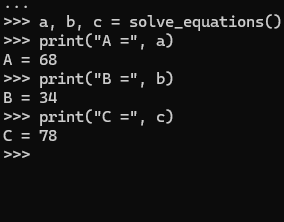
第12回 平面図形(3)
センターラインの長さ÷円周
第13回 数と規則性(2)
4/15=1/A+1/B
import matplotlib.pyplot as plt
import numpy as np
# Define a wider range for A and B
A_range = np.linspace(0.01, 20, 800)
B_range = np.linspace(0.01, 20, 800)
# Calculate corresponding values for 4/15
X, Y = np.meshgrid(A_range, B_range)
Z = 1 / X + 1 / Y
# Plot the contour plot
plt.figure(figsize=(8, 6))
plt.contour(X, Y, Z, levels=[4/15], colors='r', linestyles='solid')
plt.xlabel('A')
plt.ylabel('B')
plt.title('Contour Plot of 4/15 = 1/A + 1/B')
plt.grid(True)
plt.show()

第17回 論理 数の操作
10進数を2進数
2進数を10進数
補足
ビット(bit)とバイト(Byte)
def decimal_to_binary(decimal_num):
return bin(decimal_num)[2:]
def binary_to_decimal(binary_num):
return int(binary_num, 2)
def bits_to_bytes(bits):
return bits / 8
def bytes_to_bits(bytes):
return bytes * 8
# Converting decimal to binary
decimal_num = 10
binary_num = decimal_to_binary(decimal_num)
print(f"The binary representation of {decimal_num} is: {binary_num}")
# Converting binary to decimal
binary_num = '1010'
decimal_num = binary_to_decimal(binary_num)
print(f"The decimal representation of {binary_num} is: {decimal_num}")
# Converting bits to bytes
bits = 16
bytes = bits_to_bytes(bits)
print(f"{bits} bits is equal to {bytes} bytes")
# Converting bytes to bits
bytes = 2
bits = bytes_to_bits(bytes)
print(f"{bytes} bytes is equal to {bits} bits")
補足
部分分数分解
1/(n(n+1))
n角形の内角和=180(n-2)
n角形の対角線本数=(n-3)n(1/2)
1からはじまるn個の奇数和=n^2
